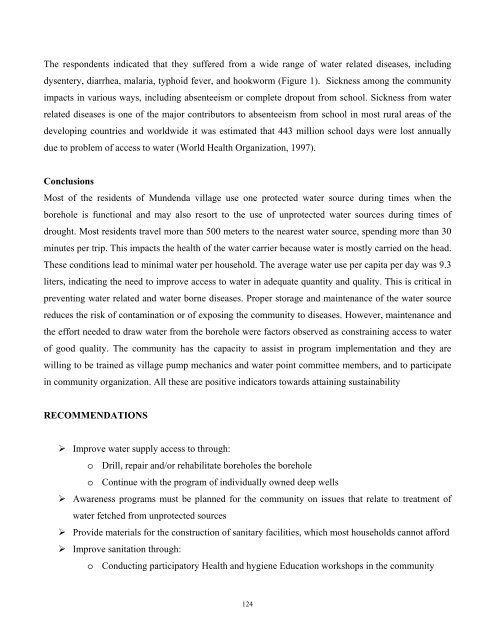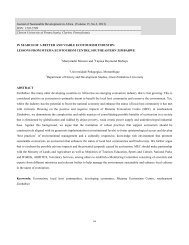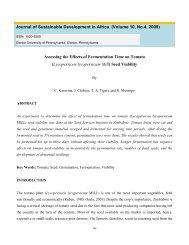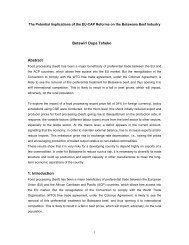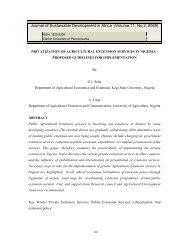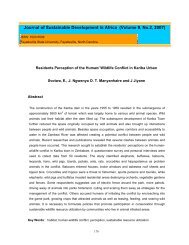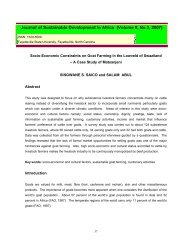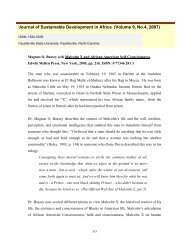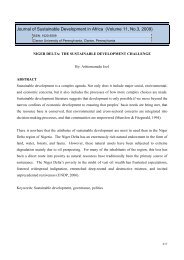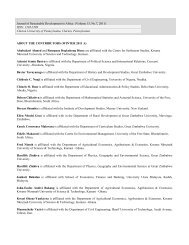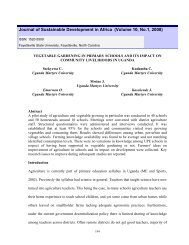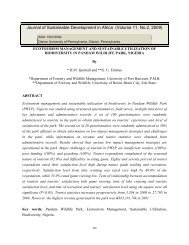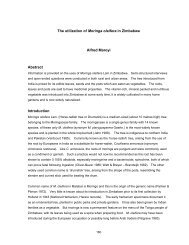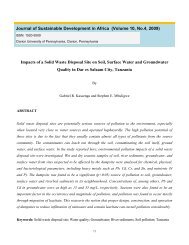Access to Safe Drinking Water by Rural Communities in Zimbabwe
Access to Safe Drinking Water by Rural Communities in Zimbabwe
Access to Safe Drinking Water by Rural Communities in Zimbabwe
You also want an ePaper? Increase the reach of your titles
YUMPU automatically turns print PDFs into web optimized ePapers that Google loves.
The respondents <strong>in</strong>dicated that they suffered from a wide range of water related diseases, <strong>in</strong>clud<strong>in</strong>g<br />
dysentery, diarrhea, malaria, typhoid fever, and hookworm (Figure 1). Sickness among the community<br />
impacts <strong>in</strong> various ways, <strong>in</strong>clud<strong>in</strong>g absenteeism or complete dropout from school. Sickness from water<br />
related diseases is one of the major contribu<strong>to</strong>rs <strong>to</strong> absenteeism from school <strong>in</strong> most rural areas of the<br />
develop<strong>in</strong>g countries and worldwide it was estimated that 443 million school days were lost annually<br />
due <strong>to</strong> problem of access <strong>to</strong> water (World Health Organization, 1997).<br />
Conclusions<br />
Most of the residents of Mundenda village use one protected water source dur<strong>in</strong>g times when the<br />
borehole is functional and may also resort <strong>to</strong> the use of unprotected water sources dur<strong>in</strong>g times of<br />
drought. Most residents travel more than 500 meters <strong>to</strong> the nearest water source, spend<strong>in</strong>g more than 30<br />
m<strong>in</strong>utes per trip. This impacts the health of the water carrier because water is mostly carried on the head.<br />
These conditions lead <strong>to</strong> m<strong>in</strong>imal water per household. The average water use per capita per day was 9.3<br />
liters, <strong>in</strong>dicat<strong>in</strong>g the need <strong>to</strong> improve access <strong>to</strong> water <strong>in</strong> adequate quantity and quality. This is critical <strong>in</strong><br />
prevent<strong>in</strong>g water related and water borne diseases. Proper s<strong>to</strong>rage and ma<strong>in</strong>tenance of the water source<br />
reduces the risk of contam<strong>in</strong>ation or of expos<strong>in</strong>g the community <strong>to</strong> diseases. However, ma<strong>in</strong>tenance and<br />
the effort needed <strong>to</strong> draw water from the borehole were fac<strong>to</strong>rs observed as constra<strong>in</strong><strong>in</strong>g access <strong>to</strong> water<br />
of good quality. The community has the capacity <strong>to</strong> assist <strong>in</strong> program implementation and they are<br />
will<strong>in</strong>g <strong>to</strong> be tra<strong>in</strong>ed as village pump mechanics and water po<strong>in</strong>t committee members, and <strong>to</strong> participate<br />
<strong>in</strong> community organization. All these are positive <strong>in</strong>dica<strong>to</strong>rs <strong>to</strong>wards atta<strong>in</strong><strong>in</strong>g susta<strong>in</strong>ability<br />
RECOMMENDATIONS<br />
‣ Improve water supply access <strong>to</strong> through:<br />
o Drill, repair and/or rehabilitate boreholes the borehole<br />
o Cont<strong>in</strong>ue with the program of <strong>in</strong>dividually owned deep wells<br />
‣ Awareness programs must be planned for the community on issues that relate <strong>to</strong> treatment of<br />
water fetched from unprotected sources<br />
‣ Provide materials for the construction of sanitary facilities, which most households cannot afford<br />
‣ Improve sanitation through:<br />
o Conduct<strong>in</strong>g participa<strong>to</strong>ry Health and hygiene Education workshops <strong>in</strong> the community<br />
124


